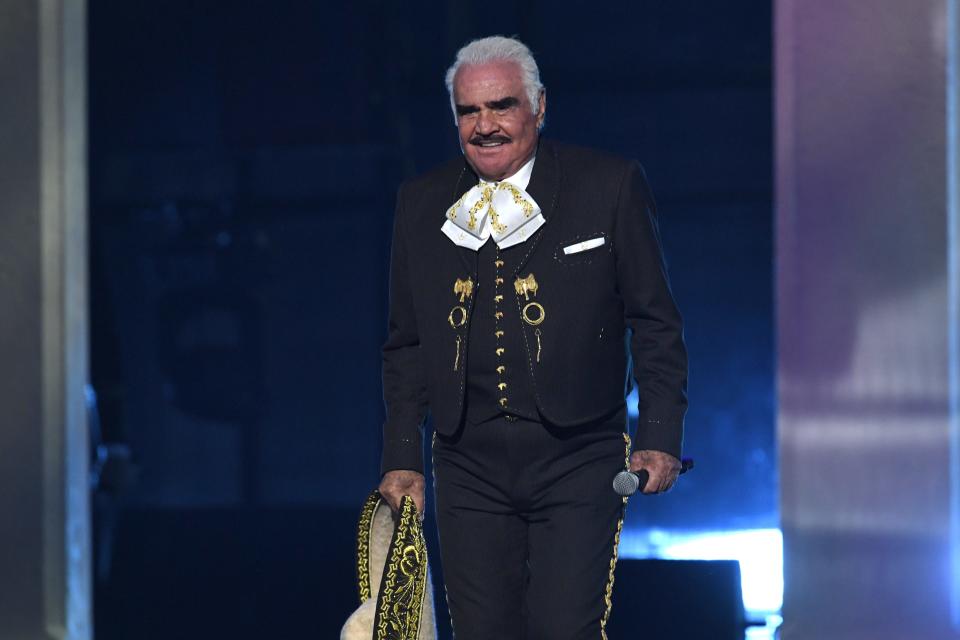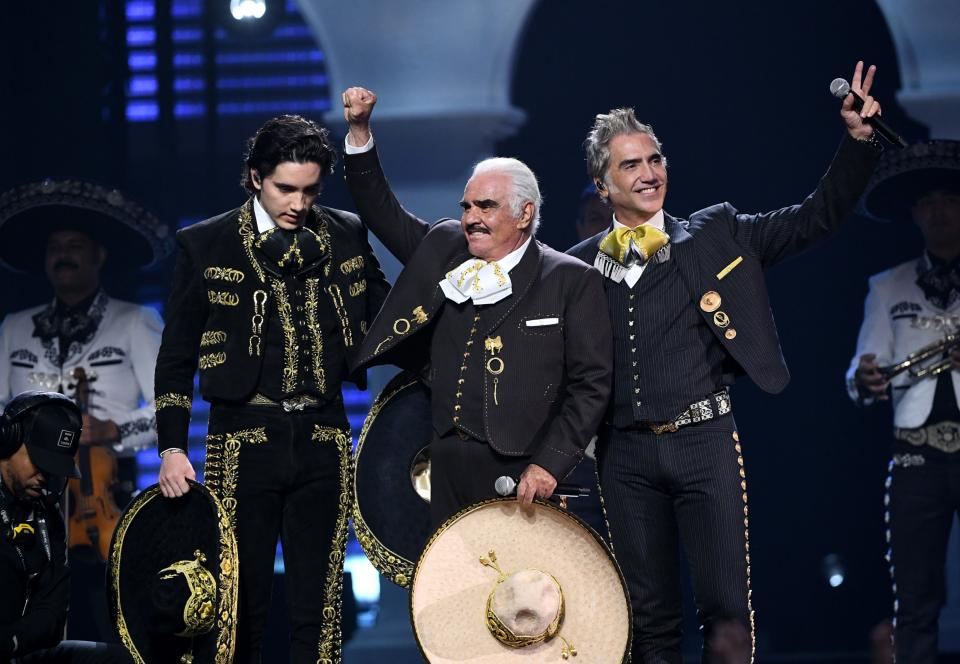Vicente Fernández died one year ago today. Here's a look at the legendary singer's impact
- Oops!Something went wrong.Please try again later.
- Oops!Something went wrong.Please try again later.
Monday marks the first mournful anniversary of legendary Mexican singer Vicente Fernández, who died in 2021 at the age of 81 after spending four months in a hospital due to Guillen-Barré syndrome in Guadalajara, Jalisco, Mexico.
Today, "Chente," as he was known by his fans, continues to be the "King of Rancheras," with almost 8 million monthly listeners on Spotify and 1.6 million monthly listeners on Pandora.
That Sunday of 2021, the news of his death was released through a statement by the Fernández family on social media.
“We regret to inform you of his death on Sunday, Dec. 12, (2021), at 6:15 a.m. It was an honor and a great pride for him to share his great musical career with everyone and to give everything for his audience. Thank you for continuing to applaud, thank you for continuing to sing", the family shared.
After having overcome prostate cancer in 2002 and a liver tumor in 2012, Chente was finally defeated by Guillain-Barré syndrome. This left him without movement in his extremities, assisted ventilation and a gastric tube through which he was fed since he could not swallow during the four months he was hospitalized.
Throughout his time in the Guadalajara hospital, which began in August 2021, his doctors assured the public that he was conscious and interacting with his family. His body eventually weakened until it reached massive organ failure, which led to his death.
Days before being hospitalized, Fernández wrote a message on his Instagram account that moved his fans, and some consider that to be his final goodbye.
“Don't give up on your dreams. Dedicating my life to singing was the best decision I could have made,” the singer wrote, finishing off with “Chente sigue siendo el rey,” an ode to his song that well established him as the “King of Rancheras.”

Farewell to 'El Rey'
After the announcement of his death, the singer's remains were transferred to the VFG Arena, located next to his Los Tres Potrillos estate in Tlajomulco de Zúñiga, Guadalajara, where his audience was able to bid him a proper farewell.
Throughout the day and night of Dec. 12 and the morning of the 13th, his admirers lined up, both in and out of the arena, to say their goodbyes.
Under the chords of all his hits, starting with “El Rey”, “México Lindo y Querido”, “Que te Vaya Bonito”, “Las Llaves de mi Alma” and many, many more, a vigil worthy of "El Rey" played out.
Legendary Mexican ranchera singer Vicente Fernández dies at 81 after recent hospitalization
As his casket sat center stage, Mariachi Azteca, one of Chente's preferred mariachi groups, played the song that he asked his fans to sing for him once he was gone: "Volver, Volver." In what is now considered Chente’s last goodbye to his fans, Alejandro Fernández, also a singer and perhaps the most popular of his three sons, complied with that wish and guided the crowd in singing for his father.
His wife, María del Refugio Abarca Villaseñor, affectionately known as Doña Cuquita, said goodbye to him by kissing the coffin. Next to his mother, Alejandro Fernández sang the song "Amor de los dos", while he comforted her, hugged her and together they mourned the loss of the great Chente.
After allowing the public to say goodbye to the iconic singer, his coffin was transferred to his estate, where his family privately said their final goodbyes.
Two bio series follow his life story
After the death of the singer, Televisa, Mexico's largest mass media company, announced the bio series "El Último Rey, El Hijo del Pueblo," based on the book of the same name, an unauthorized biography of the Argentine writer Olga Wornat, with which the television station assured it would pay tribute to the late Vicente Fernández.
Before the premiere of the series, Doña Cuquita issued a statement in which she expressed her objection. “I want to tell the entire public that I am very sad about everything that is happening right now. Vicente left, but I think there are people who are abusing his name. They did a series... they released it now that he is no longer here, but if he was here, he would be supporting me," she said.
Vicente 'Chente' Fernández mourned by wife, sons and thousands of fans during memorial service
Televisa and Univisión premiered the series, produced by Juan Osorio and starring Pablo Montero, even though the family filed a lawsuit against Televisa. What outraged the Fernández family the most was that in addition to highlighting his career, issues of his personal and intimate life were also portrayed, such as the kidnapping of his son Vicente Ferández Jr. in 1998.
Osorio maintained that it was a tribute, produced with the best intentions.
Amid the controversy, the singer's family announced the premiere in August of a bio series they did approve of, "El Rey, Vicente Fernández", produced by Netflix and that Chente authorized before he died. According to the family, Chente told his story to the writers of TV Caracol from Colombia, co-producers of the series.
Mexican actor Jaime Camil, who costarred alongside Gina Rodriguez in "Jane The Virgin," plays Chente in the series.

Who was Vicente Fernández?
Chente recorded more than 100 albums, sold over 70 million copies, starred in 34 films in Mexican cinema and recorded more than 300 songs. He went on to produce great hits like "Volver, Volver," "Por Tu Maldito Amor," "Hermoso Cariño" and "El Rey," a song that very much does justice to his moniker as King of Rancheras.
“As long as you don't stop clapping, your Chente doesn't stop singing," he would tell his fans while he belted out his songs on stage. True to his word, he was known for having concerts that lasted at least 4 hours.
He did just that in 2016 when he said his goodbye to the stage during a free farewell concert in México City at Azteca Stadium. After that, he retired to his home where he never stopped producing music.
Fernández is survived by his wife Cuquita Abarca, his four children Vicente Jr., Gerardo, Alejandro, and Alejandra (his niece, whom he always considered his daughter), nine grandchildren (four children of Vicente Jr. and five of Alejandro) and four great-grandchildren.
Throughout his career, Chente, as he is lovingly referred to by his fans, distinguished himself by taking Mexican music around the world throwing the longest concerts on the most renowned stages — making a name not only for himself but also for the popular love ballads and ranchera music that characterize México.
Snoop Dogg calls Vicente Fernández 'one of the greats' in concert tribute
Five years after he announced his farewell from the stage, his songs continue to be an inspiration to people in Latin American countries, México and the U.S., shaping cultures and musical tastes as his rancheras cast stories of sorrow, hope, love and especially Mexican pride for all to enjoy.
Vicente Fernández Gómez was born on February 17, 1940, in Huentitán El Alto, Jalisco, the son of Ramón Fernández and Paula Gómez de Fernández. His first contact with music was in his first years of life, when his parents took him to the cinema to see Pedro Infante films. He quickly became a fan and learned Infante's songs.
At age 6 he told his mother that when he grew up he wanted to be just like Infante, a famous singer — a dream he would very much grow to accomplish. At age 8 he began guitar lessons.
In his biography, produced by Sony Music, he points out that in 1954 at the age of 14, he won an amateur singing contest in Guadalajara, playing at private parties and serenading young women alongside the mariachis of his town. But he combined these jobs with helping his father doing fieldwork and was not able at the time to dedicate himself fully to producing music.
The success that he was having would lead him later to dedicate himself completely to singing and to travel regularly to México City, to the emblematic Plaza Garibaldi where popular restaurants such as "El Amanecer Tapatío" opened their doors to his musical talent.
Legendary Mexican singer Vicente Fernández hospitalized after a fall at his ranch
In 1963, the same year that he lost his mother to a battle with cancer, Chente married his lifelong partner María del Refugio "Cuquita" Abarca Villaseñor. They would go on to have four children: Alejandro, Vicente, Alejandra and Gerardo. His estate in Guadalajara, Los Tres Potrillos, would be named after his love of horses and his three sons — the three foals.
Two years later, in 1965, Fernández decided to try to record with a record company, although without much success since at that time strong figures in ranchera music such as Javier Solís were at the peak of their career success. In 1966, before the death of the great Solís, the record companies began to call on Fernández, who with his great voice was the ideal artist that would help preserve ranchera music.
It would be CBS — now Sony Music — who hired him, recording his first hits: “Tu Camino y El Mío,” “Perdóname” and “Cantina del Barrio”. It would be just the beginning, Fernández began with great success on radio and better sales on records. Albums like "Soy de Abajo", "Ni en Defensa Propia" and "Palabra de Rey" broke sales records in the genre.
One of Vicente's greatest successes is undoubtedly “Volver Volver”, a song composed by Fernando Z. Maldonado. The song became an anthem of ranchera music and in 1976 broke all sales records in North and South America, giving Fernández the title of "King of Rancheras."
Chente received countless honors, especially as his music made its way to the U.S.
He went on to win three Grammys. One in 2010 for Best Regional Mexican Album “Necesito de Ti.” Another in 2015 for the same category. And finally, in 2017, the recording of his final performance on stage in 2016, titled “Un Azteca en el Azteca (En Vivo),” landed him his last Grammy.
From 1989 to 2014, he was awarded eight Latin Grammys, 14 Premios Lo Nuestro awards and a handful of Billboard awards.
With his characteristic charro suit, wide brim hat and impeccable mariachi musicians at his side, he will forever be remembered as one of the greatest interpreters of mariachi in México and the world.
This article originally appeared on Arizona Republic: Vicente Fernández died one year ago. Here's a look at his life, legacy

